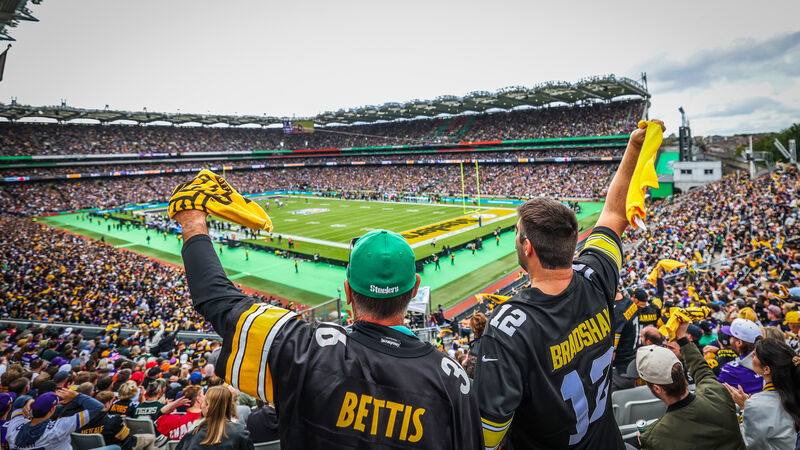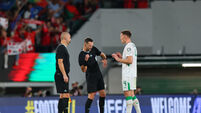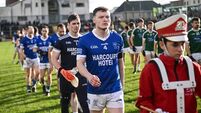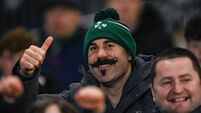Christy O'Connor: NFL show the 46th big non-GAA sporting event at Croke Park

TALKING POINTS: Sunday was the 46th big sporting event outside of Gaelic Games hosted by Croke Park, ranging from American football, athletics, rugby, soccer, baseball, boxing to the Special Olympics. Pic: ©INPHO/James Crombie
When Michael McQuaid of Pro Football Ireland was interviewed on Newstalk Breakfast on Friday ahead of Sunday’s Pittsburgh Steelers-Minnesota Vikings NFL game, McQuaid lamented that it took the NFL 28 years to come back to Dublin after their first venture here with a pre-season game between the Steelers and the Chicago Bears in July 1997.
McQuaid was even more excited with the game being staged in Croke Park, especially when he said that you “could count on two hands” the amount of non-GAA events ever staged at GAA Headquarters.
That’s the perception but it’s not the reality. Croke Park hasn’t staged as many non-GAA games, or sporting events, as a stadium with its current capacity could. But it has still hosted a lot more big sporting occasions than a lot of people think.
Sunday was the 46th big sporting event outside of Gaelic Games hosted by Croke Park, ranging from American football, athletics, rugby, soccer, baseball, boxing to the Special Olympics.
Croke Park only hosted the opening and closing ceremonies of the 2003 Special Olympics but it first staged a multi-events extravaganza 101 years ago - the 1924 Tailteann Games when some 6,500 competitors took part across several sports, from countries as wide apart as Canada and New Zealand.
The 1928 Tailteann Games were even more successful, but the decision to stage the 1932 Tailteann Games just prior to the Olympics in Los Angeles backfired, as few international athletes made it to Croke Park.
Different team sports have been on show at the venue since 1946 when an American football and a baseball exhibition game were staged there between US servicemen who’d returned from WW2 and were still based in England.
When two teams from the US Navy – USS Fresno and USS Johnston – played another exhibition baseball game in Croke Park in 1948, a crowd of 21, 269 turned up. Two US Air Force sides based in the UK – the Burtonwood Bullets and the Wethersfield Raiders – played a US Air Force American football League game in 1953 but the sides were also playing to raise funds for the Irish Red Cross.
It was another 43 years before American football returned to Croke Park when Notre Dame and Navy faced off in the Shamrock Classic in November 1996. After the Steelers and the Bears arrived eight months later, the next – and only – American football match played at Croke Park prior to yesterday was a College game between Penn State and UCF in 2014.
Although Rule 42 (which prohibited the playing of foreign games at GAA owned stadiums) was in place for all but one of those above events, the rule was only applied in practise to soccer and rugby, which were perceived to be rival games.
Cricket was also banned but Croke Park is too small for a cricket field. However, the Australia national cricket team had a training session on Jones’ Road in 2010 ahead of their One Day International against Ireland.
Croke Park also staged two boxing matches on the one card in July 1972 when Muhammad Ali fought Al ‘Blue’ Lewis, with Ali wining by TKO in the 11th round. Joe Bugner also knocked out Paul Nielsen in the undercard.
That fight was just one of seven sporting events in Croke Park across a span of 50 years but the floodgates opened when Rule 42 was relaxed in 2005 for the duration of the reconstruction of Lansdowne Road.
By the time the Republic of Ireland football and Ireland rugby internationals moved into the new Aviva Stadium upon its opening in May 2010, there had been 28 games played in Croke Park, 15 rugby and 13 soccer. It was a happy hunting ground for both teams, with Ireland only losing five of 27 matches, four in rugby and one in soccer.
When Munster and Leinster met in the 2009 Heineken Cup semi-final, the sellout crowd of 82,203 set a world record attendance for club rugby union at that time. That set a benchmark for club rugby that has become a trend in the last year since Leinster returned to Croke Park.
When the Blues went up against Northampton Saints in the 2024 ERC Cup semi-final, Munster in the URC last October, and the Bulls in the URC final back in June, all three attendances set records for a Champions Cup fixture, a URC fixture and a domestic league final respectively. Leinster also took on Harlequins at Headquarters in the ERC back in April.
Sunday may have been all razzmatazz but three sellout crowds in the fourth largest stadium in Europe - the largest not used primarily for football – in just the last 17 months proves that there has been a lot more non-GAA events staged in Croke Park than people think.
In mid-September 1999, Holycross-Ballycahill and Carrick Swans clashed in Cashel for a county quarter-final replay. The drawn match at the same venue three weeks earlier had been a tense and low-scoring affair but Holycross-Ballycahill kicked on in the replay to win by 1-16 to 1-12.
That was as far as Holycross-Ballycahill’s season extended though, as Toomevara edged past them in the semi-final. And it’s taken Holycross-Ballycahill 26 years to reach another Tipp semi-final, a step they finally took when beating Cashel King Cormacs in Saturday’s quarter-final.
It's been a slow road back to this point. Holycross-Ballycahill had been in a semi-final too in 1997, which they lost to Mullinahone, but they struggled to build on those two semi-final appearances in three years, failing to even reach the quarter-finals in 2000 and 2001. In 2002, they lost the first round of the county championship to Ballingarry.
It took a long time for Holycross-Ballycahill to be regarded as a threat at the business end of the senior championship again but they certainly are now. After turning into a real underage powerhouse, they endorsed their status as the coming team in Tipperary at the outset of this championship when impressively beating Kiladangan and Toomevara. After racking up 4-19 and 2-25 in those two games, Holycross-Ballycahill showcased that scoring prowess again on Saturday when blitzing Cashel for 4-23.
Holycross-Ballycahill have been outstanding to date but the next step now is to try and reach a first county final since 1991, a match they lost to Cashel King Cormacs. And that’s what made Saturday’s win even sweeter.
When Louth full-back Dermot Campbell was interviewed after Dreadnots comprehensive Louth senior football quarter-final win against Cooley Kickhams on Saturday night, the fusion of hurt and ambition in Campbell’s voice mirrored the Dreadnots performance.
“We’ve been written off probably for eight, nine, ten years,” said Campbell. “People have said the Dreadnots are finished. We ended up in a relegation battle for one or two years…but we all knew the talent that was in the group. There is a lot of hurt in there. We know that on our day nobody would want to play us.” Dreadnots have been infused by the energy and class of four young players this year but it’s been a long decade of hurt, longing and searching for Campbell and a host of this side since the agony of losing the 2014 county final to St Patrick’s by two points. Two years earlier, Dreadnots reached their first final, which they also lost to St Patrick’s.
When Dreadnots last appeared in a semi-final in 2023, they lost by one point to a Naomh Máirtin side that subsequently lost the county final to St Mary’s by one point. They’re still rank outsiders in this championship but Dreadnots may be a good outside bet to win a first Louth senior title.



